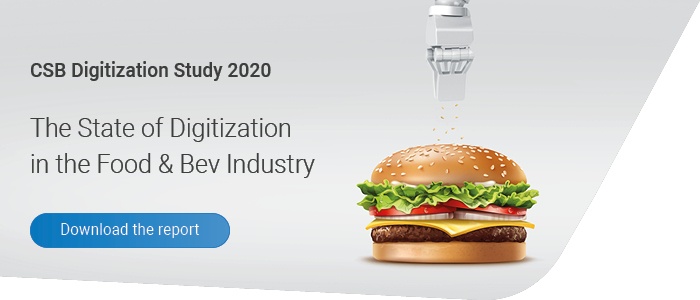“Industry 4.0” is one of the key topics in the future of the food industry. How digitalization creates new opportunities with regard to optimizing processes and increasing efficiency.
Once the finished flour at GoodMills in Schwechat embarks on its journey to the customer, it has already passed through various stations beforehand: it was ground, filled, labeled and stacked onto pallets, entered and removed from storage and then loaded onto trucks. Nothing special so far. The fact that this is done fully automatically however is very special. How is this possible? By connecting and automating production, logistics and business partners, says managing Director Gregor Trieb. This however requires the deployment of suitable business software: "We manage our resources, logistical processes and the service areas, such as accounting, with the CSB-System. We do not have any stand-alone solutions, and all employees work with the same software. By now the integration has reached a degree so we can even control our machines and equipment with the software”, says Trieb.
The process: Once the different types of flours have been filled into packages or sacks, conveyors move them on to the next stages of processing. Every single packaging
unit is labeled, scanned and thus entered in the information system without requiring manual intervention of the staff. On goes the conveyor, forwarding the units a short distance to the automatic palletizer, which stacks them on pallets according to a defined pattern. At the end, the pallets are wrapped, marked with pallet labels and moved to the warehouse via roller tracks - and all of this happens in a fully automated manner.
30 Pallets per hour
"In comparison to before, the throughput in the entire technical order handling process from filling to the entry of our products into storage has increased considerably. We can now handle up to 30 pallets per hour”, says Trieb.
This level of productivity can only be achieved as machines, systems and robot units exchange data with the ERP software in real time by means of MES applications. For example, palletizer and wrapper choose the appropriate programs for every product group based on the item master data from the CSB-System. The labeling units, too, are connected to the software system. They receive any relevant data automatically, for instance item number, ordered units, batch number, production date and sell-by date as well the Serial Shipping Container Code for unambiguous tracing of the products.
Higher flexibility for the customer
Moreover, the business has become more flexible with regard to customer needs. For example, retailers order so-called “Düsseldorf pallets”. These are half pallets that can
be used for displaying the products. First, the pallets are stretch wrapped and labeled one by one. After that, theyare entered in pairs and moved to the wrapper again so they can be wrapped together, and a common pallet label is attached. “Today we are even more flexible in meeting the requirements of the market and of our customers, as we can process many different types of pallets in an efficient and economical manner,” says Trieb.
Mobile terminal devices ensure more efficiency in storage
At the warehouse, too, the flour specialist profits from the efficiency gains. Here, the pallets are no longer entered manually, but with hand-held radio devices that communicate with the CSB-System. The software then assigns the right storage position for each pallet based on defined stock putaway rules and the data of CSB-Inventory Management. Once the pallet has reached its destination, all that remains to be done is to scan the barcode at the bin location. In the background, the software automatically completes all other processes, such as updating the stock on hand.
Minimum scheduling work
GoodMills has also digitized its processes in route scheduling. Today, carrier information is no longer exchanged on the phone, but via a specifically designed web portal. Carriers log on to a web portal, distribute the assigned orders to their vehicles and choose a free time slot for loading. Order picking is completed shortly before the trucks arrive and the ordered products are placed at the ramp. The driver receives the loading list for the route and the corresponding loading gate opens. As the roller tracks installed on the ground can be locked and unlocked by means of the IT system to prevent carriers from loading wrong items. Then, the delivery documents are printed and the delivery quantities are booked - done. “The work involved in communicating with our carriers is now reduced to a minimum. There are no more inconsistencies in the timing for loading the trucks at our premises, and the carriers do not have to put up with long waiting times anymore. We know exactly which carrier is coming when, and which goods have to be supplied to the ramp and at what time.”
It therefore comes as no surprise that Gregor Trieb is fully convinced of the benefits that digitalization provides for the logistics center. The manager is already planning further steps toward reaching the smart food factory.


